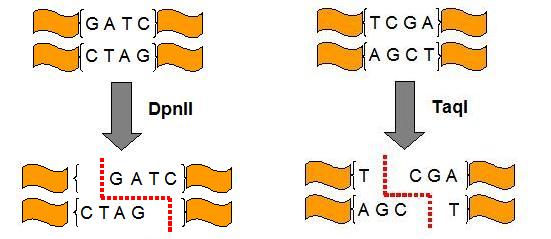Team:Imperial College London/M3/RestrictionEnzymes
From 2009.igem.org

Contents |
 Module 3: Genome Deletion Overview
Module 3: Genome Deletion Overview
Restriction Enzymes
Restriction enzymes will cleave DNA at particular recognition sites. This leads to multiple double-stranded breakages in DNA, which are unlikely to be repaired in time and will subsequently result in cell death. Restriction enzymes are therefore highly toxic to the cell, where even minute amounts can induce destruction of the genome.
In our system, we have made use of these properties of restriction enzymes. The restriction enzymes DpnII and TaqI are produced. These serve to effectively remove the genetic material from our E.ncapsulator.
DpnII and TaqI are 4 base cutters, specifically targetting and cutting the sequences GATC and TCGA respectively.

4 base cutters were chosen as they have a higher frequency of cleavage. Assuming equal distribution of nucleotides, each nucleotide has an equal probabiliy of occurring at any site.
The probability of cleavage for a 4-base long sequence is :
1/4 x 1/4 x 1/4 x 1/4 = (1/4)4
This means that on average the four cutter will cut every 256 base pairs. Given that the genome of E.coli is around 4 million base pairs, it will become totally digested.
This ensures that the genetic material contained within the cell will all be destroyed, including any inserted DNA.
Having 2 different restriction enzymes is part of a failsafe engineering design. These restriction enzymes have similar recognition sequences, allowing for an overlap in cleavage capabilities. When both restriction enzymes are expressed, there is comprehensive cutting, but when one enzyme becomes mutated and dysfunctional, the other restriction enzyme still works well by itself. Therefore, by using two restriction enzymes, we can be more certain that our DNA has been digested.
A distinct advantage of using restriction enzymes for our 'killing' mechanism is that the the genetic material is removed, but the cell membrane is left intact. Therefore, the protein of interest will still be protected by the encapsulated cell. This renders the bacterium no more than an inanimate shell loaded with our protein drug of interest.
References
[http://www.rebase.neb.com| Rebase]
Module 3 - Genome Deletion






 "
"




